The First Roll – 120 Minutes of Nervousness
My first self-developed black-and-white roll — from choosing the film to the very last drop in the wetting agent bath.
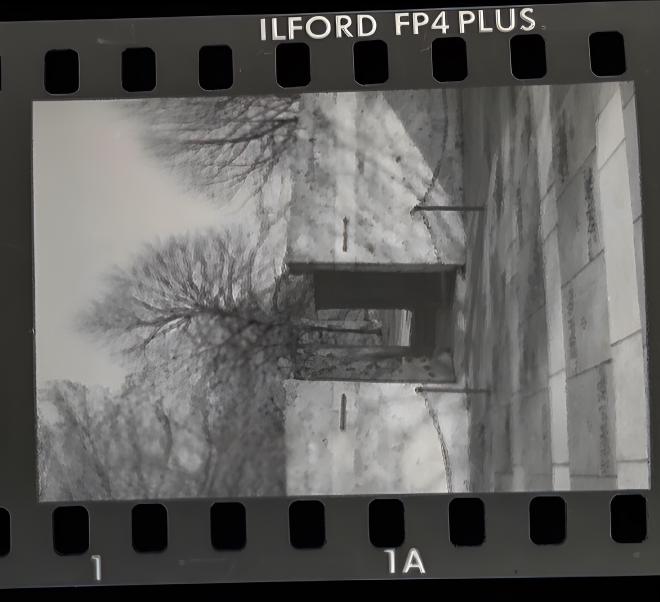
Why black and white? To be honest: because it felt like the easiest way back in. My father and I used to develop black-and-white film in the basement when I was a kid, and even though that was decades ago, it still felt like the most natural starting point. Why my dad never tried C-41 is something I’ll never know — and sadly can’t ask him anymore. Maybe it was too pricey, maybe too finicky. Black and white, though, was familiar, tactile, and within reach.
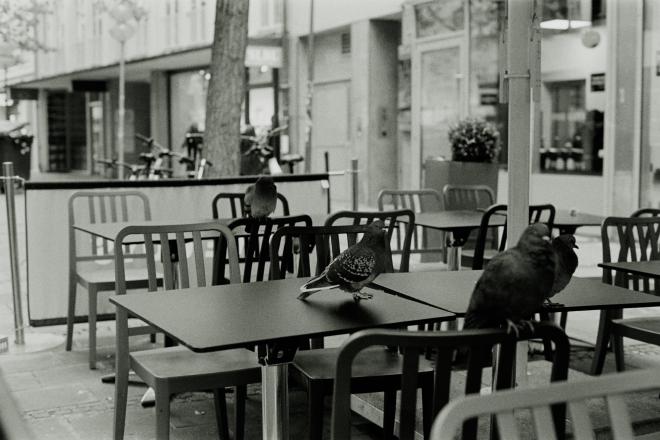
So why return to analog photography now?
Over the past few years, photography has become more than a hobby for me. It’s a way to slow down, to refocus, to shut out the noise for a while. And the more comfort I found in it, the stronger the desire became to simplify. Less tech. Fewer menus. Fewer distractions. Just making decisions again — intentionally. And yes, I also wanted to prove to myself that I could still develop film.
Pentax MX, ME, and Rediscovering Old Habits #
My journey back began with a Pentax MX I found on a classifieds site and brought back to life myself. A lovely camera — fully mechanical, a beautiful honest clack, and a bright viewfinder. But somehow it didn’t match how I shoot today. Digitally, I almost always work in aperture priority, and the MX simply doesn’t offer that.
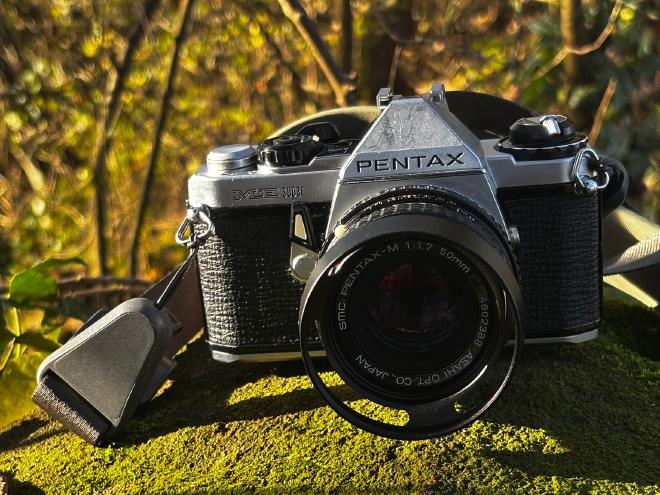
Funny enough, the Pentax ME — especially the ME Super — felt instantly familiar. I suspect one of them might have been my very first “real” SLR. Either way, the MX opened the door back into film photography, while the ME Super feels like reconnecting with something from childhood.
My Current Favorite Combo: Ilford HP5+ in FX-39 II #
In the meantime, I’ve settled into a method that works for me. And instead of boring you with every failed attempt, here’s the combo I keep coming back to: Ilford HP5+ developed in Adox FX-39 II. It gives me consistent, classic-looking results that scan beautifully without feeling overly processed.
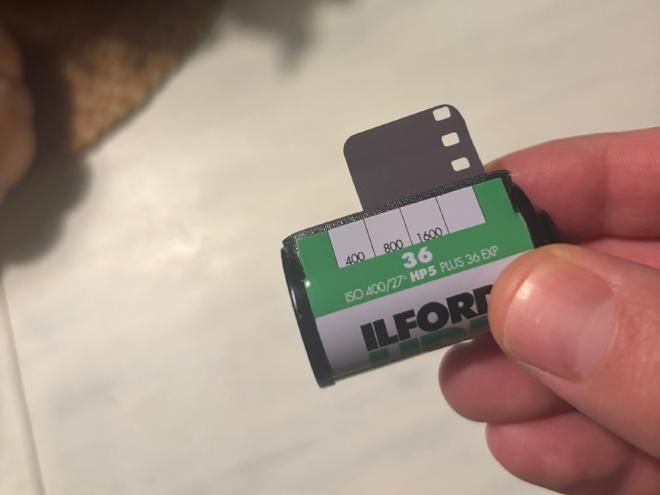
Prep Work: The Water Bath #
To control temperature, I use a Eurobox roughly 12×16×12 inches. I fill it about 8 inches deep with 68 °F (20 °C) water. All the chemicals go into it, plus a bottle of distilled water for the wetting agent.
Pro tip: glass bottles don’t float — even when they’re almost empty. PET bottles do, and it gets annoying fast.
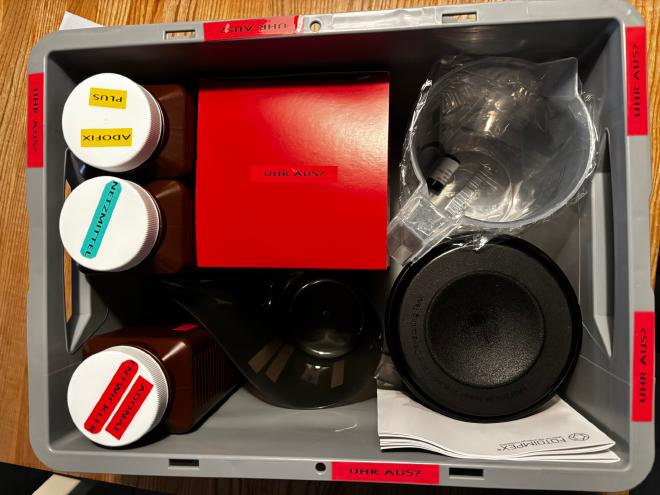
Before starting, I set everything out:
measuring cups, funnels, timer, a jug for used chemicals, the Paterson tank, and of course the loaded film. Developer and fixer stay strictly separate — their own funnels, their own cups.
The Developer: FX-39 II at 1+9 #
My Paterson tank requires 300 ml total.
So I mix 30 ml FX-39 II with 270 ml water from the temperature bath. The naturally soft Lake Constance water works really well for this.
The fixer gets mixed once and lasts about ten rolls. I put a strip of masking tape on the bottle and keep a tally. Fix times get slightly longer with each use — better too long than too short. Over-fixing isn’t an issue.
I also mix up a wetting agent bath: distilled water plus a few drops of wetting agent to prevent mineral spots.
The Process — From Tank to Negative #
Once everything in the water bath hits 68 °F, it’s go time.
Pre-Soak and the “Pfutzg” Test #
I start with a one-minute pre-soak, gently agitating the tank — no shaking. Then I pour the water out.
Now comes something surprisingly important: the lid and the famous pfutzg.
A new Paterson tank lid is stiff, so I practice a few times. When developing, I press the lid on firmly — and then lift it just a hair to let air escape.
If you hear a soft pfutzg, you know the lid is seated correctly.
Why it matters:
- No pressure buildup when closing
- No chemical splashes while agitating
- Smoother, more consistent agitation
- A clean workspace
As we say in Swabia: “Wenn’s pfutzgt, isch’r dicht.”
(If it goes pfutzg, it’s sealed.)
Developing #
I pour in the developer quickly but calmly. Lid on, timer running.
- First minute: continuous agitation
- One firm tap to dislodge air bubbles
- Each following minute: 10 seconds of agitation
- Total time for HP5+: 12 minutes
During the final minute, the tank rests. Ten seconds before the time is up, I pour the developer into a waste container — never down the drain.
Stop Bath #
For stopping, I use water from the temperature bath.
Three fills, about five inversions each. I tried vinegar and citric acid, but citric acid caused bright spots on one roll — plain water just works.
Fixing #
Fixer in, one minute of continuous agitation, then 10 seconds per minute. Afterwards, it goes back into the bottle and gets another tally mark. A funnel with a mesh keeps silver particles from scratching later rolls.
Washing: The Ilford Method #
Efficient and water-friendly:
- Fill with 600 ml, invert 2× → dump
- Fill, invert 4× → dump
- Fill, invert 8× → dump
- Fill, invert 16× → dump
- Fill, invert 32× → done
Wetting Agent and Drying #
After the final rinse, the film goes into the wetting agent bath for about a minute. A gentle swirl is enough — no foam. Then I hang it up to dry in the shower. Bathrooms are usually the least dusty rooms; sometimes I even mist the walls to trap stray dust.
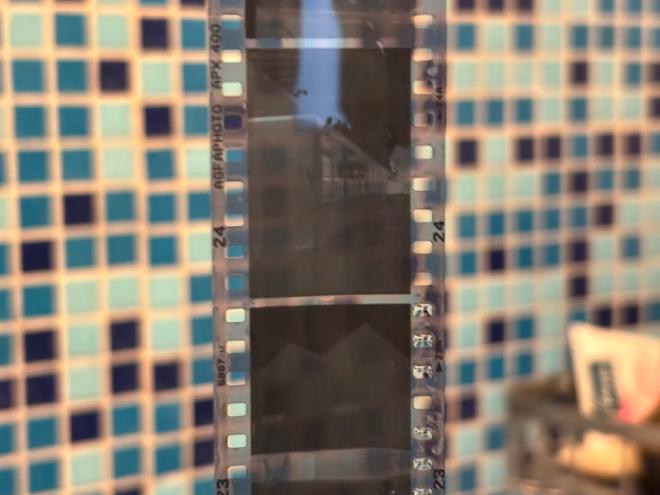
Whether you should squeegee the film is a matter of debate. I’ve used my fingers — it works most of the time, though occasionally I still get water spots.
When it’s finally hanging there, drying in the shower, I catch myself standing in front of it just like I did in my father’s basement decades ago — waiting to see if everything turned out. And that moment — that quiet mix of nervousness and anticipation — is probably the real reason I came back to all of this.